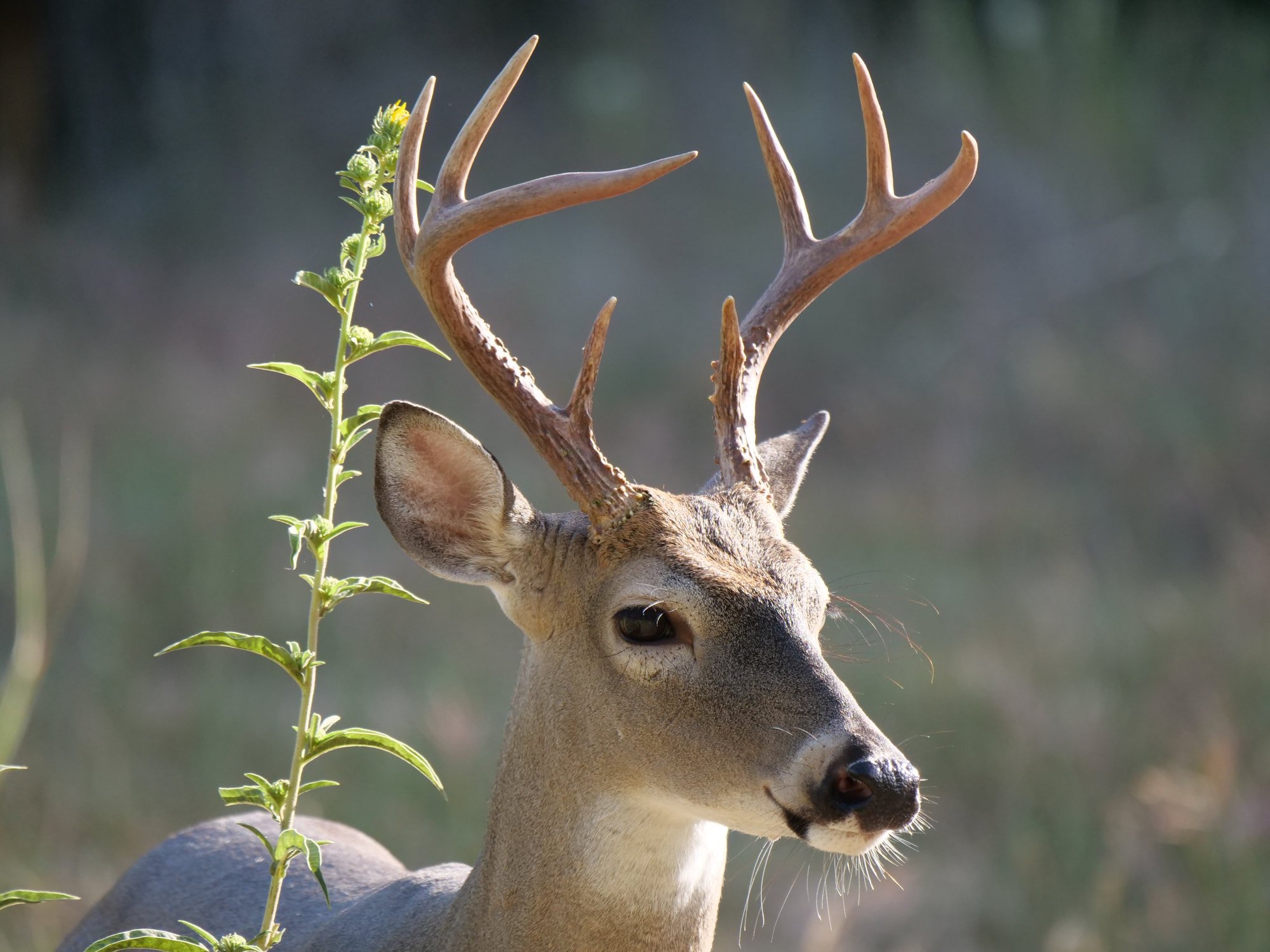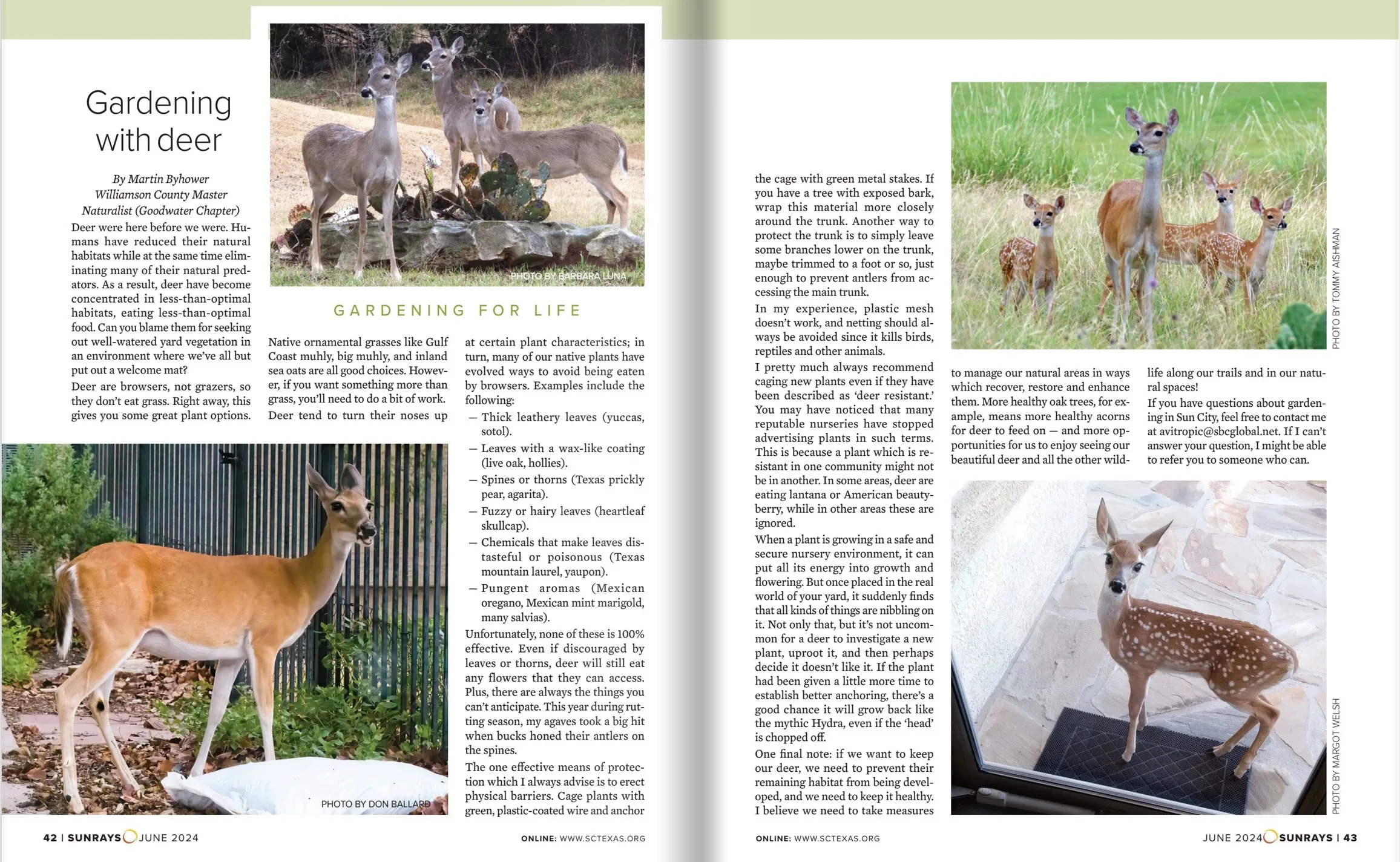
Full disclosure;
As a designer of sustainable, wildlife friendly gardens and landscapes, I find that deer are my single biggest challenge! Yes, they are cute and endearing as well as benign in most ways. But they play havoc with landscaping, whether you’re using native plants or not. And they are one of the biggest threats to wild bird populations! This is true because in areas where they are overpopulated, they overgraze the shrubs and small trees of the forest understory, which provide food and shelter to numerous species of birds and other animals.
Dealing with deer involves trial and error and astute observation in order to detect their grazing presence. They can wipe out a newly planted bed in a day, sampling yet never actually eating a single plant. New plants smell especially interesting because of the soil that they are in; they are particularly vulnerable because they are easily uprooted and because they haven’t developed the phytotoxin chemicals that will make at least some of them unpalatable to deer and other pests, eventually.
In helping folks choose which plants to use and then protecting a garden in areas where deer are present, I do the following.
•First, I like to find out what the deer in that particular area are eating. Many plants listed as deer resistant may not be so in certain neighborhoods, where the “deer culture” has come to relish them. For a variety of reasons, “deer resistant” plants become more resistant the longer they are in the ground. But if deer become overpopulated and their densities are not controlled, they will eat non-preferred items out of desperation.
•Next, if deer are an issue in the vicinity, I select a pallette of plants that I believe will work.
• If the yard is fenced, deer will easily hop most fences under 6 or less feet high. The trick is to line the inside of the fence with plants, yard art, large rocks, etc. all about a few feet in from the fence. Deer have poor depth perception and won't leap into a yard if they can't see a landing spot. In my 7 years in Sun City, deer are in the unfenced part of my yard daily but have never hopped my fence!
•I cage most plants when I first plant them, because of the previously mentioned issues. The only ones I don’t cage are most bunchgrasses, yuccas (although deer will eat the red flower stalks of red yuccas), cacti, and a few proven broadleaf plants. I may remove the cages if deer are unlikely to rut on the branches and the plant has been in the ground for a period of time, or (obviously) if the plant is growing taller than deer can reach. However, if there is a plant I really want to grow in my yard, I might leave it caged indefinitely. Deer may use the edges of expensive Whale’s Tongue and other agaves during rutting season from fall through winter, and I am now caging these during this time. The green plastic coated metal mesh material, not to mention the nonmetallic (green) plastic mesh, are not unappealing to me if they protect the plants I really like!
•Don't feed them! It is illegal in most communities because it does more harm that good for all wildlife, including deer themselves. Use mammal repelling birdseed or suet that contains CAYENNE PEPPER to keep ALL mammals (especially squirrels but also deer) away from your feeders.
•There are lots of other ways to discourage deer, but I haven’t found one yet that works consistently over time. Deer Scram may be the best repellent product (it lasts longer than others and doesn't smell awful). Without wolves and mountain lions, coyotes are the deer’s only remaining predator, but coyotes usually only take fawns or weakened individuals.
if you have gotten this far and still have questions, I’d be happy to try to answer them if you email me at avitropic@sbcglobal.net. Stay green!
See below for a list of deer resistant plants….
OK, here are plants that in MY EXPERIENCE, deer USUALLY leave alone! Non-natives have an asterisk. Plants that are sometimes eaten are italicized. Plants that should be caged in rutting season to avoid damage are in red.
American Beautyberry
Anacacho Orchid
Bee Balm/Horsemint/Lemon Mint/Bergamot
Blackfoot Daisy
Blue agave
Bluebonnets
Burford Holly*
Carolina Jessamine
Chile Pequin/Chile Petin
Copper Canyon Daisy*
Crossvine
Damianita
Datura /Jimson Weed/Angel trumpet
Dwarf Palmetto
Elbow Bush
Esperanza, (Yellow Bells)
Esperanza, Sangria
Flame Acanthus
Frostweed
Garlic Chives*
Gaura, most types
Golden Groundsel
Honeysuckle, Coral
Indian Blanket /Gaillardia
Inland Sea Oats
Lantana, Native Texas
Maximilian Sunflower
Mexican Feathergrass*
Mexican Hat (Ratibida)
Mexican Mint Marigold*
Milkweed: Antelope Horns, Butterflyweed, and others
MIstflowers; Blue, Fragrant, and Gregg’s
Muhlys: Big, Gulf Coast and Bamboo
Nolina (all species)
Palmetto, Texas Dwarf
Prairie Verbena
Prickly Pears; Old Mexico*, Santa Rita and Spineless
Pride of Barbados*
Red Buckeye
Red Yucca (but cage when flower stalks are present)
Sabal Palm, dwarf
Sage, “Lipstick” Salvia hybrid
Cedar Sage
Indigo Spires, Salvia hybrid
Sage, Mealy Blue 'Henry Duelberg’
Sages: Autumn sage (Salvia greggi) varieties including Pink, Red, and White
Tropical Sage,
Santolina, Gray*
Sedges: Webberville and Woodland
Skeletonleaf Goldeneye
Skullcaps: Heartleaf and Pink*
Sotol (all species)
Sumac, Flameleaf and Evergreen
Texas Betony
Texas Persimmon
"Texas Sages": Cenizo (Leucophyllum), Compact, Convent, and Green
Tree Senna
Turk's Cap
Twistleaf Yucca
Whale’s Tongue Agave
Wooly Stemodia
Yarrows: Moonshine and others
Yaupon Holly
Zexmenia, Orange
